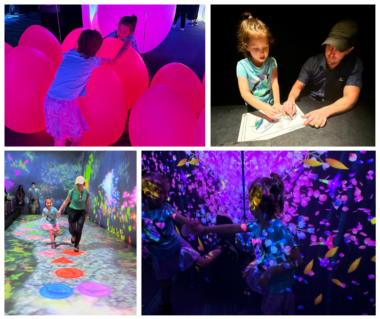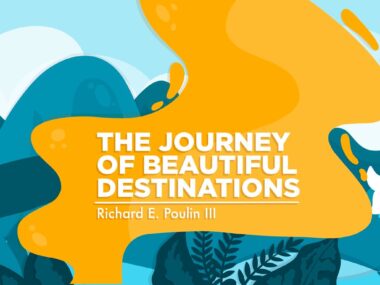Why teamLab is perfect for our child with AADC deficiency
Choosing safe and accessible destinations is a must for our family
Written by |

Finding places to visit with our 6-year-old daughter, Rylae-Ann, has been challenging. But keeping her unique needs in mind when planning makes the process much easier.
Rylae-Ann was born with aromatic l-amino acid decarboxylase (AADC) deficiency, a rare neurotransmitter disease. Its symptoms make it challenging to visit typical locations for family outings.
Children with AADC deficiency have low muscle tone and usually require a special hybrid of wheelchair and stroller. Choosing a location that is wheelchair-friendly is essential.
Another difficult symptom to manage is autonomic nervous system dysfunction. This makes it difficult for children with AADC deficiency to regulate body temperature, so they are prone to excessive sweating. This means that outdoor trips depend on temperature and weather conditions.
In addition to managing symptoms, we also need a location that supports Rylae-Ann’s progress. One area of focus has been improving her sensory integration. We found that the array of therapy sessions she participates in would be more successful if she didn’t have anxiety-triggered events due to sensory processing issues.
One family outing that has never failed us is a trip to teamLab art installations. Founded in 2001 in Tokyo, teamLab is an international, interdisciplinary, creative group that brings together professionals from various fields including artists, programmers, engineers, CG animators, mathematicians, and architects. teamLab is known for its innovative digital installations that blend art, technology, and natural elements to create immersive and interactive experiences.
The cool, dimly lit indoor locations make it a great option regardless of the weather or time of year.
teamLab Singapore

Columnist Richard E. Poulin III’s daughter, Rylae-Ann, was only a few weeks old when she visited her first teamLab art installation in Singapore. (Photo by Richard E. Poulin III).
Our family’s journey with teamLab installations began in Singapore, where we first lived. We became instant fans when we encountered the mesmerizing world of digital art. The immersive experience left us yearning for more, and our travels soon took us to other teamLab locations in Japan and Taiwan.
Each visit has been unique, yet all have offered a sensory and creative experience that transcends traditional art exhibits, making it accessible and enjoyable for everyone in our family, including our neurodivergent child.
In Singapore, we saw teamLab’s “Future World” exhibit at the ArtScience Museum. The integration of educational elements with artistic displays was perfect for Rylae-Ann. We learned about nature and technology through interactive exhibits like “Sketch Aquarium,” in which drawings of sea creatures came to life on a digital screen. The inclusive design, with sensory-friendly spaces and clear signage for spacious restrooms, made it easy for our daughter to navigate and enjoy the exhibit.
teamLab Japan

A photo collage of teamLab art exhibits in Japan. (Photo by Richard E. Poulin III).
Next, during a trip to Japan, we visited teamLab’s “Borderless” exhibit in Tokyo, which left us spellbound. Digital artwork that constantly changed and responded to our movements was all around us as we navigated the maze-like spaces.
The “Forest of Lamps” and “Crystal World,” where lights and sounds created an enchanting environment, particularly captivated Rylae-Ann.
Accessibility features like wide pathways ensured that our entire family could comfortably explore everything with all of our supplies.
During a return trip to Japan, we explored teamLab “Planets,” which offered a different yet equally engaging experience. There, we waded through knee-deep water in one exhibit, watched flowers bloom and scatter in another, and became part of the art in an interactive, multisensory environment. The tactile and visual stimuli provided a calming and engaging experience for our neurodivergent child, who found joy in the installation’s predictable patterns and responsive elements.
teamLab Taiwan

Rylae-Ann’s latest teamLab visit was in Taiwan. (Courtesy of Richard E. Poulin III).
Our latest adventure took us to Taiwan, where teamLab’s installations again amazed us with their creativity and accessibility. “Future Park” in Taipei offered an expansive space where children could run, play, and interact with the art.
The “Graffiti Nature” exhibit, where flowers and animals we had colored emerged from under our feet, was a highlight. The thoughtful design, including quiet areas and sensory-friendly features, ensured a comfortable experience for Rylae-Ann.
Each teamLab installation has provided a unique, immersive experience that stimulates the senses and sparks creativity. The interactive nature of the exhibits allowed our family to engage deeply with the art, making it an ideal outing. Importantly, teamLab’s commitment to accessibility ensures that children with neurodivergent or other accessibility issues can fully participate and enjoy the experience.
Our family trips to teamLab installations have been unforgettable. The blend of art, technology, and inclusivity makes it a perfect destination for AADC deficiency families seeking a unique and enriching experience. We look forward to discovering more teamLab locations in the future and continuing our journey through this magical world of digital art.
Note: AADC News is strictly a news and information website about the disease. It does not provide medical advice, diagnosis, or treatment. This content is not intended to be a substitute for professional medical advice, diagnosis, or treatment. Always seek the advice of your physician or other qualified health provider with any questions you may have regarding a medical condition. Never disregard professional medical advice or delay in seeking it because of something you have read on this website. The opinions expressed in this column are not those of AADC News or its parent company, Bionews, and are intended to spark discussion about issues pertaining to aromatic l-amino acid decarboxylase deficiency.






Leave a comment
Fill in the required fields to post. Your email address will not be published.